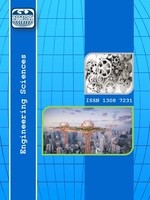EKSANTRİK YÜKLÜ TEMELLERDE TAŞIMA GÜCÜ VE GERİLME DAVRANIŞININ SAYISAL ANALİZİ
Temeller düşey merkezi yükün yanında, eğilme momentinin de etkisinde kalabilmektedirler. Eğilme momentleri de genellikle yatay yüklerden (deprem, rüzgar, su, yanal zemin basınçları vs.) meydana gelmektedir. Komşu yapı temelinin inşa edilecek bina temeline çok yakın olması durumunda, konsol davranışı gösteren temellerde, istinat duvarı, yüksek kule temeli, köprü ayağı, payanda, tünel gibi inşaatlarda temeller eksantrik olarak yüklenebilmektedirler. Bu çalışmada, sonlu elemanlar yöntemine dayanan iki boyutlu Plaxis 2D (Finite Element Code for Soil and Rock Analysis) bilgisayar yazılımı kullanılarak sayısal analizler gerçekleştirilmiştir. Analizlerde kullanılan modelin doğruluğu ve tutarlılığı, literatürde mevcut deneysel gerilme deformasyon bağıntıları modellenerek tespit edilmiştir. Çalışmada, temel geometrisi (kare, daire), zemin türü (kil, kum) ve yükleme koşulları (merkezi, eksantrik) gibi parametrelerin yüzeysel temellere ait taşıma gücü, oturma ve düşey gerilme karakteristikleri üzerindeki etkileri araştırılmıştır
NUMERICAL ANALYSIS OF BEARING CAPACITY AND STRESS BEHAVIOUR OF ECCENTRICALLY LOADED FOOTINGS
Footings are structural elements transmit the static, dynamic, horizontal and vertical structure loads to the underlying soils safely and economically. Apart from the vertical axial loads, the footings of portal framed buildings are often subjected to eccentric loads caused by forces of earth pressures, earthquakes, water, wind, etc. For designing footings subjected to earthquake forces, adopting appropriate values of horizontal and vertical seismic coefficients, equivalent seismic forces can be conveniently evaluated. These forces in combination with static forces make the foundations subjected to eccentric-inclined loads. The problems of footings subjected to eccentric inclined loads are frequently encountered in the cases of the foundations of retaining wall, abutments, columns, stanchions, portal framed buildings etc. Sometimes the corner of the column of these portal-framed buildings is located very close to the property line, and hence subjected to eccentric loading. Finite element based two dimensional computer software Plaxis 2D has been used in this study. Accuracy and consistency of the model used in the analysis has been investigated with modeling of the stress-strain behaviour of the soils existing in the literature. The effects of the footing geometry (square, circular), the soil type (clay, sand) and the loading conditions (centric, eccentric) on the bearing capacity, settlement and vertical stress characteristics of the shallow footings have been investigated.
